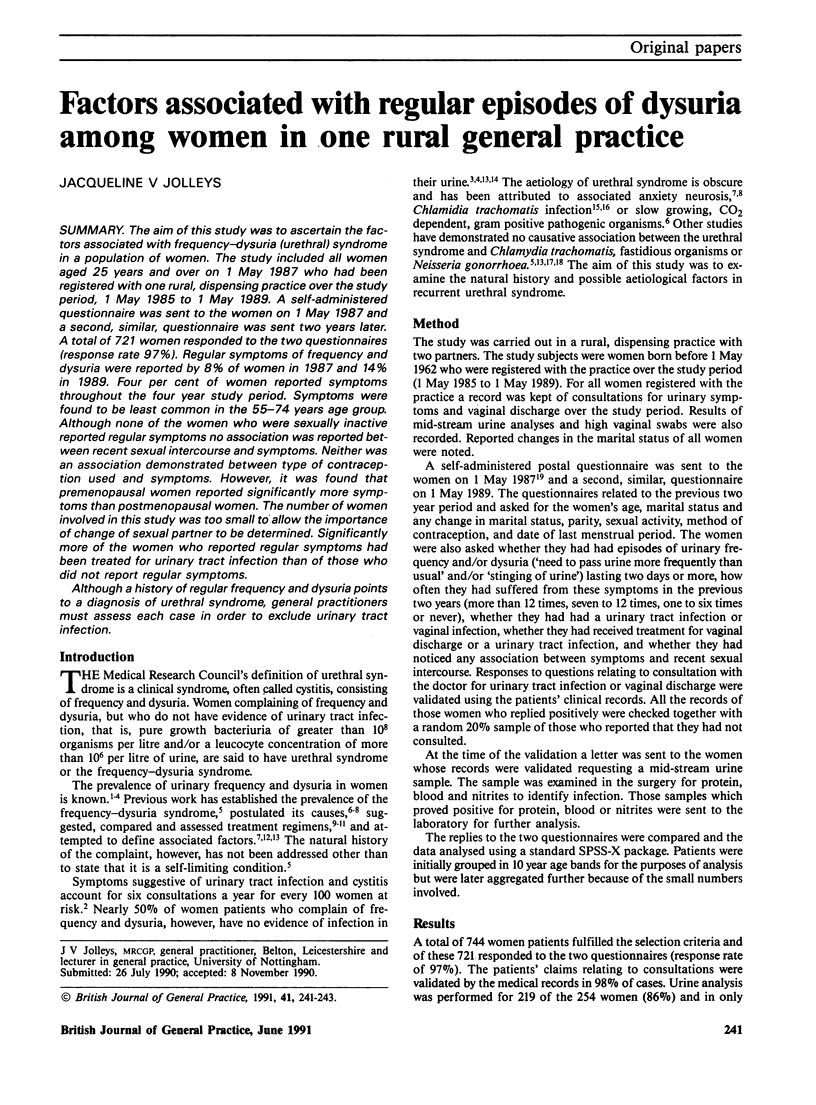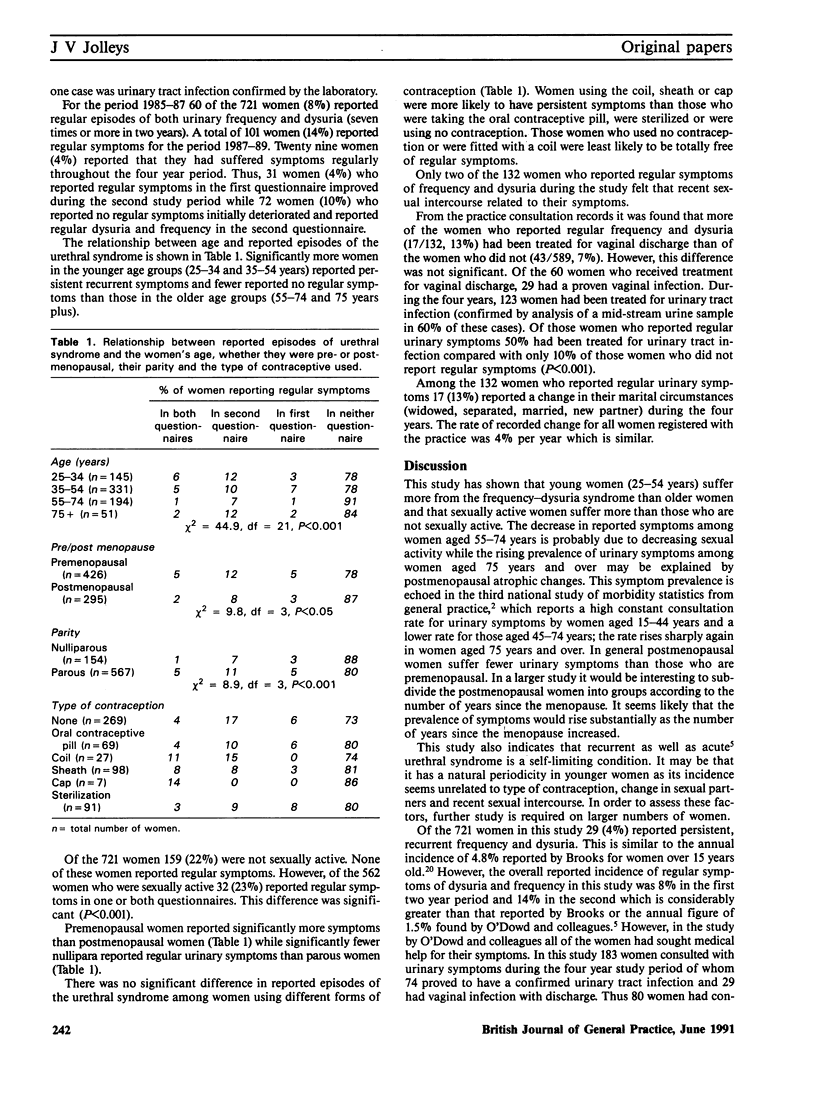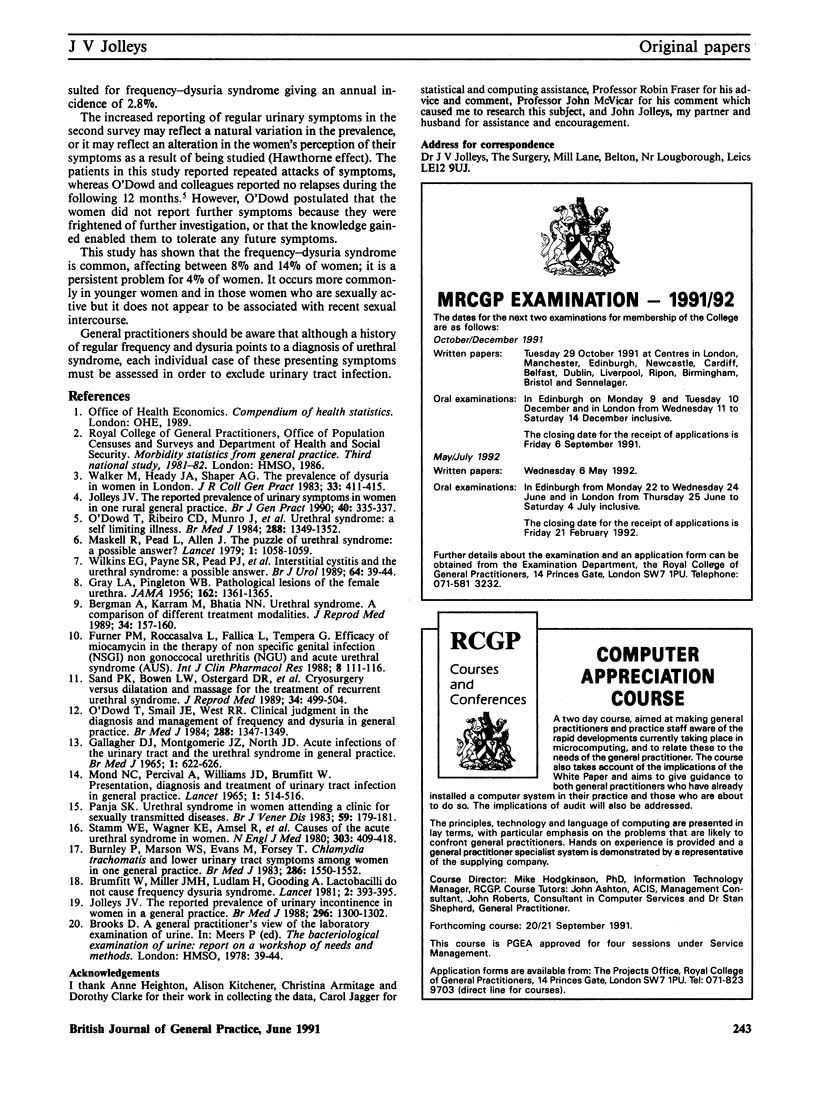Abstract
The aim of this study was to ascertain the factors associated with frequency-dysuria (urethral) syndrome in a population of women. The study included all women aged 25 years and over on 1 May 1987 who had been registered with one rural, dispensing practice over the study period, 1 May 1985 to 1 May 1989. A self-administered questionnaire was sent to the women on 1 May 1987 and a second, similar, questionnaire was sent two years later. A total of 721 women responded to the two questionnaires (response rate 97%). Regular symptoms of frequency and dysuria were reported by 8% of women in 1987 and 14% in 1989. Four percent of women reported symptoms throughout the four year study period. Symptoms were found to be least common in the 55-74 years age group. Although none of the women who were sexually inactive reported regular symptoms no association was reported between recent sexual intercourse and symptoms. Neither was an association demonstrated between type of contraception used and symptoms. However, it was found that premenopausal women reported significantly more symptoms than postmenopausal women. The number of women involved in this study was too small to allow the importance of change of sexual partner to be determined. Significantly more of the women who reported regular symptoms had been treated for urinary tract infection than of those who did not report regular symptoms. Although a history of regular frequency and dysuria points to a diagnosis of urethral syndrome, general practitioners must assess each case in order to exclude urinary tract infection.
Full text
PDF


Selected References
These references are in PubMed. This may not be the complete list of references from this article.
- Bergman A., Karram M., Bhatia N. N. Urethral syndrome. A comparison of different treatment modalities. J Reprod Med. 1989 Feb;34(2):157–160. [PubMed] [Google Scholar]
- Brumfitt W., Hamilton-Miller J. M., Ludlam H., Gooding A. Lactobacilli do not cause frequency and dysuria syndrome. Lancet. 1981 Aug 22;2(8243):393–396. doi: 10.1016/s0140-6736(81)90833-3. [DOI] [PubMed] [Google Scholar]
- Burney P., Marson W. S., Evans M., Forsey T. Chlamydia trachomatis and lower urinary tract symptoms among women in one general practice. Br Med J (Clin Res Ed) 1983 May 14;286(6377):1550–1552. doi: 10.1136/bmj.286.6377.1550. [DOI] [PMC free article] [PubMed] [Google Scholar]
- Furneri P. M., Roccasalva L., Fallica L., Tempera G. Efficacy of miocamycin in the therapy of non-specific genital infections (NSGI): non-gonococcal urethritis (NGU) and acute urethral syndrome (AUS). Int J Clin Pharmacol Res. 1988;8(2):111–116. [PubMed] [Google Scholar]
- GALLAGHER D. J., MONTGOMERIE J. Z., NORTH J. D. ACUTE INFECTIONS OF THE URINARY TRACT AND THE URETHRAL SYNDROME IN GENERAL PRACTICE. Br Med J. 1965 Mar 6;1(5435):622–626. doi: 10.1136/bmj.1.5435.622. [DOI] [PMC free article] [PubMed] [Google Scholar]
- GRAY L. A., PINGELTON W. B. Pathological lesions of the female urethra. J Am Med Assoc. 1956 Dec 8;162(15):1361–1365. doi: 10.1001/jama.1956.02970320009003. [DOI] [PubMed] [Google Scholar]
- Jolleys J. V. Reported prevalence of urinary incontinence in women in a general practice. Br Med J (Clin Res Ed) 1988 May 7;296(6632):1300–1302. doi: 10.1136/bmj.296.6632.1300. [DOI] [PMC free article] [PubMed] [Google Scholar]
- Jolleys J. V. The reported prevalence of urinary symptoms in women in one rural general practice. Br J Gen Pract. 1990 Aug;40(337):335–337. [PMC free article] [PubMed] [Google Scholar]
- MOND N. C., PERCIVAL A., WILLIAMS J. D., BRUMFITT W. PRESENTATION, DIAGNOSIS, AND TREATMENT OF URINARY-TRACT INFECTIONS IN GENERAL PRACTICE. Lancet. 1965 Mar 6;1(7384):514–516. doi: 10.1016/s0140-6736(65)92020-9. [DOI] [PubMed] [Google Scholar]
- Maskell R., Pead L., Allen J. The puzzle of "urethral syndrome": a possible answer? Lancet. 1979 May 19;1(8125):1058–1059. doi: 10.1016/s0140-6736(79)92953-2. [DOI] [PubMed] [Google Scholar]
- O'Dowd T. C., Ribeiro C. D., Munro J., West R. R., Howells C. H., Davis R. H. Urethral syndrome: a self limiting illness. Br Med J (Clin Res Ed) 1984 May 5;288(6427):1349–1352. doi: 10.1136/bmj.288.6427.1349. [DOI] [PMC free article] [PubMed] [Google Scholar]
- O'Dowd T. C., Smail J. E., West R. R. Clinical judgment in the diagnosis and management of frequency and dysuria in general practice. Br Med J (Clin Res Ed) 1984 May 5;288(6427):1347–1349. doi: 10.1136/bmj.288.6427.1347. [DOI] [PMC free article] [PubMed] [Google Scholar]
- Panja S. K. Urethral syndrome in women attending a clinic for sexually transmitted diseases. Br J Vener Dis. 1983 Jun;59(3):179–181. doi: 10.1136/sti.59.3.179. [DOI] [PMC free article] [PubMed] [Google Scholar]
- Sand P. K., Bowen L. W., Ostergard D. R., Bent A., Panganiban R. Cryosurgery versus dilation and massage for the treatment of recurrent urethral syndrome. J Reprod Med. 1989 Aug;34(8):499–504. [PubMed] [Google Scholar]
- Stamm W. E., Wagner K. F., Amsel R., Alexander E. R., Turck M., Counts G. W., Holmes K. K. Causes of the acute urethral syndrome in women. N Engl J Med. 1980 Aug 21;303(8):409–415. doi: 10.1056/NEJM198008213030801. [DOI] [PubMed] [Google Scholar]
- Walker M., Heady J. A., Shaper A. G. The prevalence of dysuria in women in London. J R Coll Gen Pract. 1983 Jul;33(252):411–415. [PMC free article] [PubMed] [Google Scholar]
- Wilkins E. G., Payne S. R., Pead P. J., Moss S. T., Maskell R. M. Interstitial cystitis and the urethral syndrome: a possible answer. Br J Urol. 1989 Jul;64(1):39–44. doi: 10.1111/j.1464-410x.1989.tb05519.x. [DOI] [PubMed] [Google Scholar]


